Alfa Romeo 166 2006 Owner handbook (in English)
Manufacturer: ALFA ROMEO, Model Year: 2006, Model line: 166, Model: Alfa Romeo 166 2006Pages: 272, PDF Size: 4.17 MB
Page 61 of 272
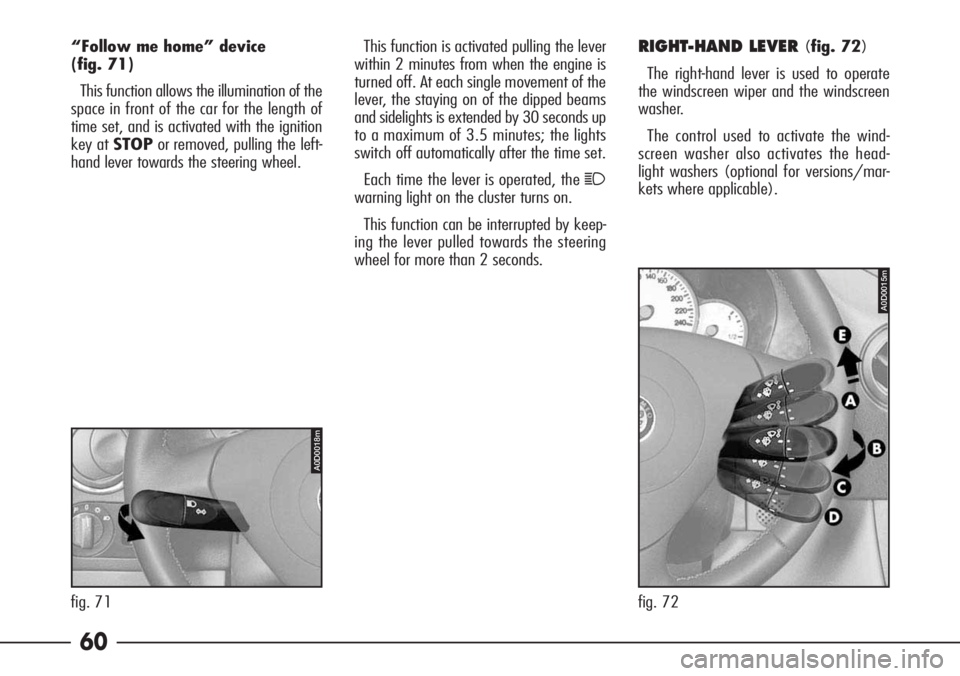
60
RIGHT-HAND LEVER (fig. 72)
The right-hand lever is used to operate
the windscreen wiper and the windscreen
washer.
The control used to activate the wind-
screen washer also activates the head-
light washers (optional for versions/mar-
kets where applicable). “Follow me home” device
(fig. 71)
This function allows the illumination of the
space in front of the car for the length of
time set, and is activated with the ignition
key at STOPor removed, pulling the left-
hand lever towards the steering wheel.This function is activated pulling the lever
within 2 minutes from when the engine is
turned off. At each single movement of the
lever, the staying on of the dipped beams
and sidelights is extended by 30 seconds up
to a maximum of 3.5 minutes; the lights
switch off automatically after the time set.
Each time the lever is operated, the
1
warning light on the cluster turns on.
This function can be interrupted by keep-
ing the lever pulled towards the steering
wheel for more than 2 seconds.
fig. 72
A0D0015m
A0D0018m
fig. 71
Page 62 of 272
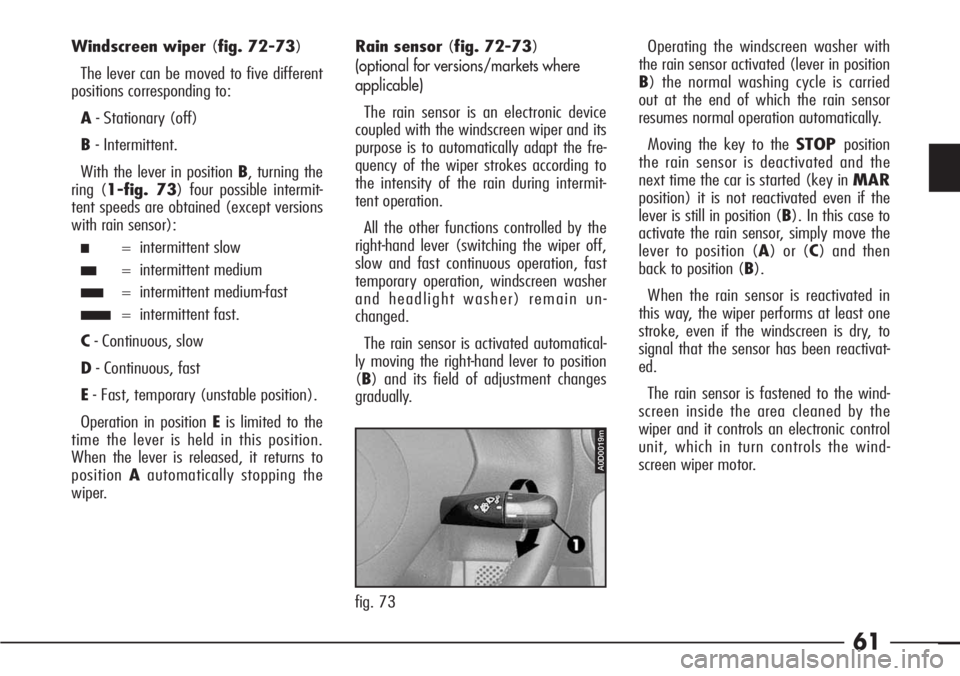
61
Windscreen wiper (fig. 72-73)
The lever can be moved to five different
positions corresponding to:
A- Stationary (off)
B- Intermittent.
With the lever in position B, turning the
ring (1-fig. 73) four possible intermit-
tent speeds are obtained (except versions
with rain sensor):
■= intermittent slow
■■= intermittent medium
■■■= intermittent medium-fast
■■■■= intermittent fast.
C- Continuous, slow
D- Continuous, fast
E- Fast, temporary (unstable position).
Operation in position Eis limited to the
time the lever is held in this position.
When the lever is released, it returns to
positionAautomatically stopping the
wiper.Rain sensor (fig. 72-73)
(optional for versions/markets where
applicable)
The rain sensor is an electronic device
coupled with the windscreen wiper and its
purpose is to automatically adapt the fre-
quency of the wiper strokes according to
the intensity of the rain during intermit-
tent operation.
All the other functions controlled by the
right-hand lever (switching the wiper off,
slow and fast continuous operation, fast
temporary operation, windscreen washer
and headlight washer) remain un-
changed.
The rain sensor is activated automatical-
ly moving the right-hand lever to position
(B) and its field of adjustment changes
gradually.Operating the windscreen washer with
the rain sensor activated (lever in position
B) the normal washing cycle is carried
out at the end of which the rain sensor
resumes normal operation automatically.
Moving the key to the STOPposition
the rain sensor is deactivated and the
next time the car is started (key in MAR
position) it is not reactivated even if the
lever is still in position (B). In this case to
activate the rain sensor, simply move the
lever to position (A) or (C) and then
back to position (B).
When the rain sensor is reactivated in
this way, the wiper performs at least one
stroke, even if the windscreen is dry, to
signal that the sensor has been reactivat-
ed.
The rain sensor is fastened to the wind-
screen inside the area cleaned by the
wiper and it controls an electronic control
unit, which in turn controls the wind-
screen wiper motor.
A0D0019m
fig. 73
Page 63 of 272
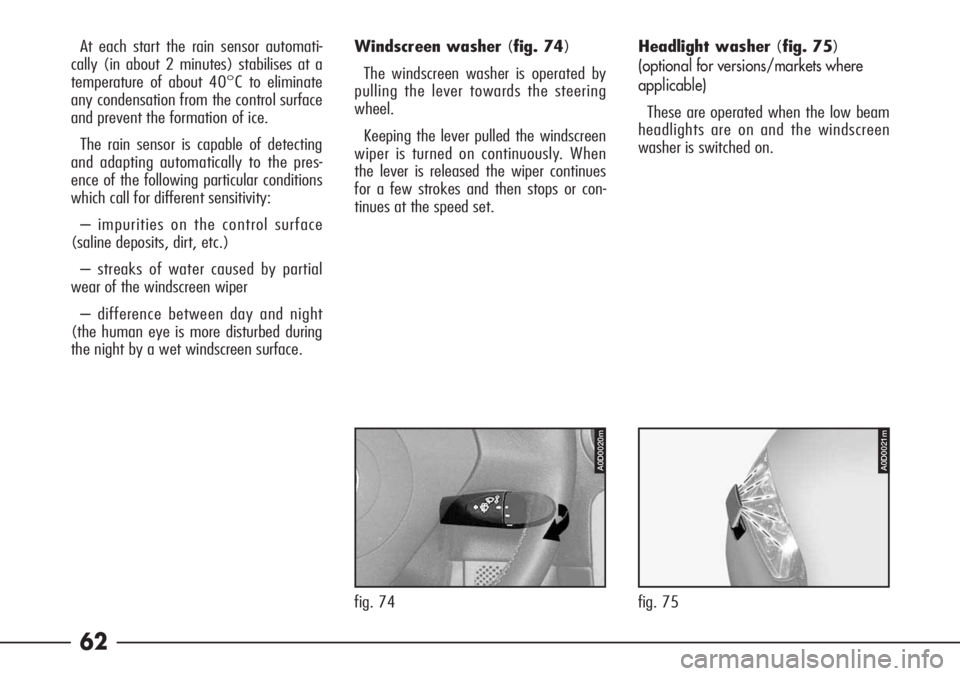
62
At each start the rain sensor automati-
cally (in about 2 minutes) stabilises at a
temperature of about 40°C to eliminate
any condensation from the control surface
and prevent the formation of ice.
The rain sensor is capable of detecting
and adapting automatically to the pres-
ence of the following particular conditions
which call for different sensitivity:
– impurities on the control surface
(saline deposits, dirt, etc.)
– streaks of water caused by partial
wear of the windscreen wiper
– difference between day and night
(the human eye is more disturbed during
the night by a wet windscreen surface.Headlight washer (fig. 75)
(optional for versions/markets where
applicable)
These are operated when the low beam
headlights are on and the windscreen
washer is switched on. Windscreen washer (fig. 74)
The windscreen washer is operated by
pulling the lever towards the steering
wheel.
Keeping the lever pulled the windscreen
wiper is turned on continuously. When
the lever is released the wiper continues
for a few strokes and then stops or con-
tinues at the speed set.
A0D0020m
fig. 74
A0D0021m
fig. 75
Page 64 of 272
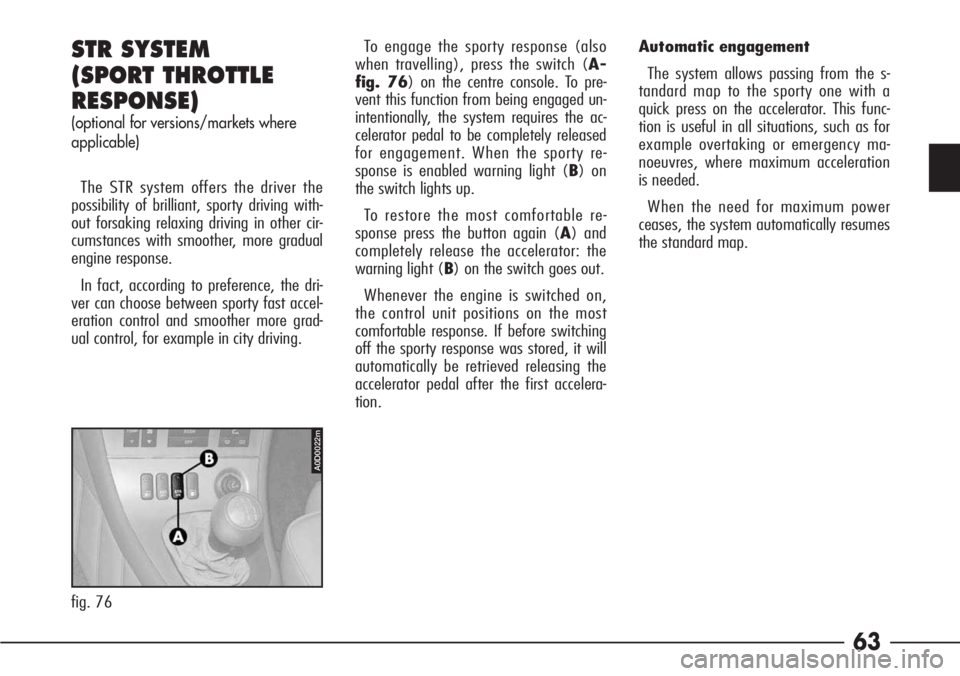
63
STR SYSTEM
(SPORT THROTTLE
RESPONSE)
(optional for versions/markets where
applicable)
The STR system offers the driver the
possibility of brilliant, sporty driving with-
out forsaking relaxing driving in other cir-
cumstances with smoother, more gradual
engine response.
In fact, according to preference, the dri-
ver can choose between sporty fast accel-
eration control and smoother more grad-
ual control, for example in city driving.To engage the sporty response (also
when travelling), press the switch (A-
fig. 76) on the centre console. To pre-
vent this function from being engaged un-
intentionally, the system requires the ac-
celerator pedal to be completely released
for engagement. When the sporty re-
sponse is enabled warning light (B) on
the switch lights up.
To restore the most comfortable re-
sponse press the button again (A) and
completely release the accelerator: the
warning light (B) on the switch goes out.
Whenever the engine is switched on,
the control unit positions on the most
comfortable response. If before switching
off the sporty response was stored, it will
automatically be retrieved releasing the
accelerator pedal after the first accelera-
tion.Automatic engagement
The system allows passing from the s-
tandard map to the sporty one with a
quick press on the accelerator. This func-
tion is useful in all situations, such as for
example overtaking or emergency ma-
noeuvres, where maximum acceleration
is needed.
When the need for maximum power
ceases, the system automatically resumes
the standard map.
A0D0022m
fig. 76
Page 65 of 272
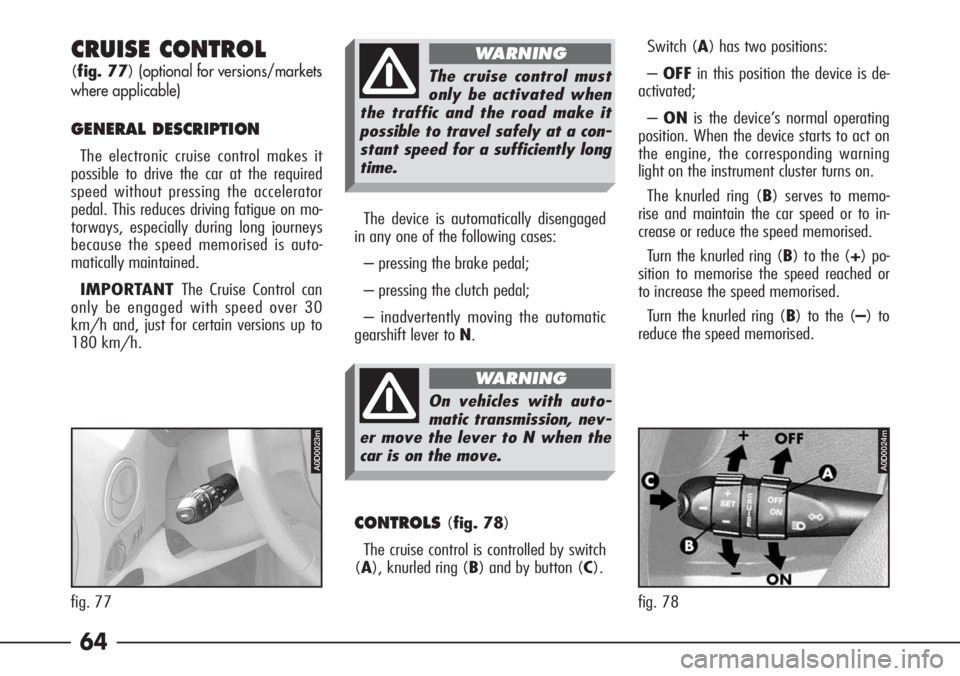
64 CRUISE CONTROL
(fig. 77)(optional for versions/markets
where applicable)
GENERAL DESCRIPTION
The electronic cruise control makes it
possible to drive the car at the required
speed without pressing the accelerator
pedal. This reduces driving fatigue on mo-
torways, especially during long journeys
because the speed memorised is auto-
matically maintained.
IMPORTANT The Cruise Control can
only be engaged with speed over 30
km/h and, just for certain versions up to
180 km/h.
CONTROLS(fig. 78)
The cruise control is controlled by switch
(A), knurled ring (B) and by button (C).Switch (A) has two positions:
–OFFin this position the device is de-
activated;
–ONis the device’s normal operating
position. When the device starts to act on
the engine, the corresponding warning
light on the instrument cluster turns on.
The knurled ring (B) serves to memo-
rise and maintain the car speed or to in-
crease or reduce the speed memorised.
Turn the knurled ring (B) to the (+) po-
sition to memorise the speed reached or
to increase the speed memorised.
Turn the knurled ring (B) to the (–) to
reduce the speed memorised.
The cruise control must
only be activated when
the traffic and the road make it
possible to travel safely at a con-
stant speed for a sufficiently long
time.
WARNING
On vehicles with auto-
matic transmission, nev-
er move the lever to N when the
car is on the move.
WARNING
The device is automatically disengaged
in any one of the following cases:
– pressing the brake pedal;
– pressing the clutch pedal;
– inadvertently moving the automatic
gearshift lever to N.
A0D0024m
fig. 78
A0D0023m
fig. 77
Page 66 of 272
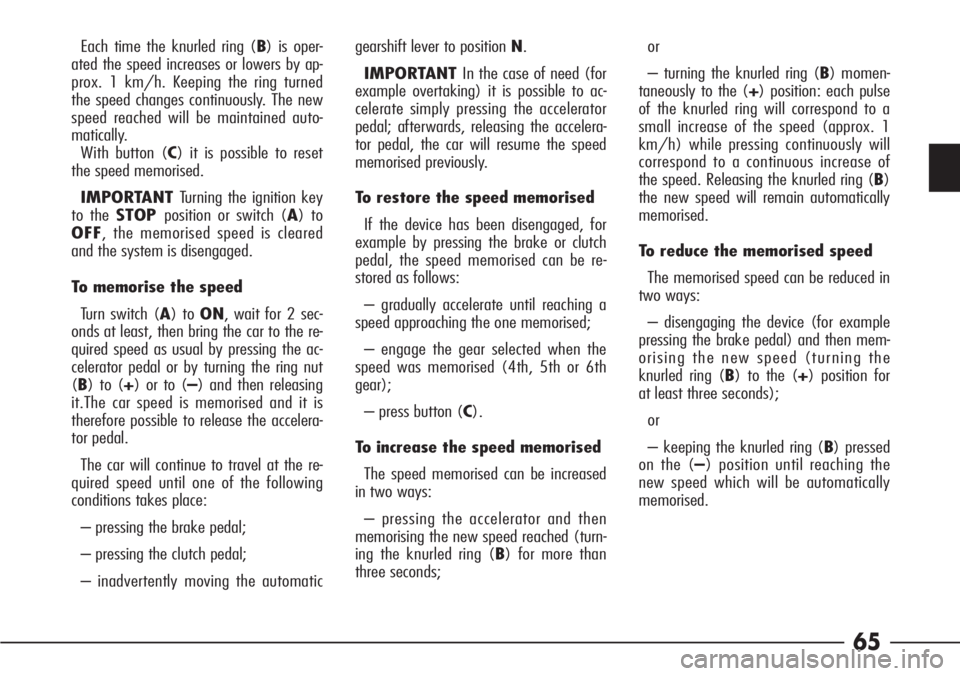
65
Each time the knurled ring (B) is oper-
ated the speed increases or lowers by ap-
prox. 1 km/h. Keeping the ring turned
the speed changes continuously. The new
speed reached will be maintained auto-
matically.
With button (C) it is possible to reset
the speed memorised.
IMPORTANT Turning the ignition key
to the STOPposition or switch (A) to
OFF, the memorised speed is cleared
and the system is disengaged.
To memorise the speed
Turn switch (A) to ON, wait for 2 sec-
onds at least, then bring the car to the re-
quired speed as usual by pressing the ac-
celerator pedal or by turning the ring nut
(B) to (+) or to (–) and then releasing
it.The car speed is memorised and it is
therefore possible to release the accelera-
tor pedal.
The car will continue to travel at the re-
quired speed until one of the following
conditions takes place:
– pressing the brake pedal;
– pressing the clutch pedal;
– inadvertently moving the automaticgearshift lever to position N.
IMPORTANT In the case of need (for
example overtaking) it is possible to ac-
celerate simply pressing the accelerator
pedal; afterwards, releasing the accelera-
tor pedal, the car will resume the speed
memorised previously.
To restore the speed memorised
If the device has been disengaged, for
example by pressing the brake or clutch
pedal, the speed memorised can be re-
stored as follows:
– gradually accelerate until reaching a
speed approaching the one memorised;
– engage the gear selected when the
speed was memorised (4th, 5th or 6th
gear);
– press button (C).
To increase the speed memorised
The speed memorised can be increased
in two ways:
– pressing the accelerator and then
memorising the new speed reached (turn-
ing the knurled ring (B) for more than
three seconds;or
– turning the knurled ring (B) momen-
taneously to the (+) position: each pulse
of the knurled ring will correspond to a
small increase of the speed (approx. 1
km/h) while pressing continuously will
correspond to a continuous increase of
the speed. Releasing the knurled ring (B)
the new speed will remain automatically
memorised.
To reduce the memorised speed
The memorised speed can be reduced in
two ways:
– disengaging the device (for example
pressing the brake pedal) and then mem-
orising the new speed (turning the
knurled ring (B) to the (+) position for
at least three seconds);
or
– keeping the knurled ring (B) pressed
on the (–) position until reaching the
new speed which will be automatically
memorised.
Page 67 of 272
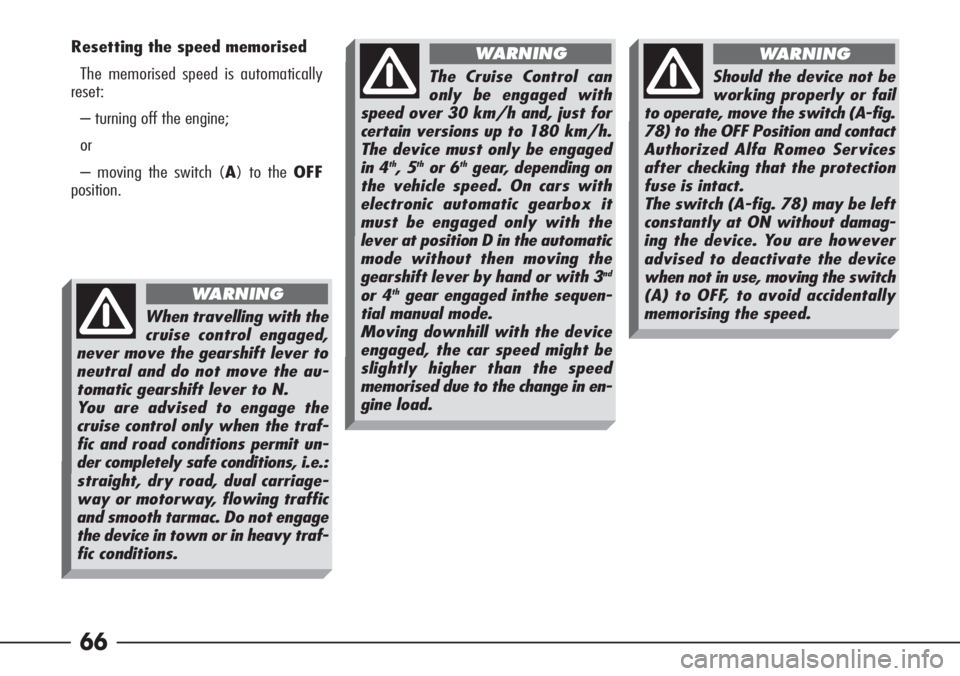
66
Resetting the speed memorised
The memorised speed is automatically
reset:
– turning off the engine;
or
– moving the switch (A) to the OFF
position.
When travelling with the
cruise control engaged,
never move the gearshift lever to
neutral and do not move the au-
tomatic gearshift lever to N.
You are advised to engage the
cruise control only when the traf-
fic and road conditions permit un-
der completely safe conditions, i.e.:
straight, dry road, dual carriage-
way or motorway, flowing traffic
and smooth tarmac. Do not engage
the device in town or in heavy traf-
fic conditions.
WARNING
The Cruise Control can
only be engaged with
speed over 30 km/h and, just for
certain versions up to 180 km/h.
The device must only be engaged
in 4
th, 5thor 6thgear, depending on
the vehicle speed. On cars with
electronic automatic gearbox it
must be engaged only with the
lever at position D in the automatic
mode without then moving the
gearshift lever by hand or with 3
nd
or 4thgear engaged inthe sequen-
tial manual mode.
Moving downhill with the device
engaged, the car speed might be
slightly higher than the speed
memorised due to the change in en-
gine load.
WARNING
Should the device not be
working properly or fail
to operate, move the switch (A-fig.
78) to the OFF Position and contact
Authorized Alfa Romeo Services
after checking that the protection
fuse is intact.
The switch (A-fig. 78) may be left
constantly at ON without damag-
ing the device. You are however
advised to deactivate the device
when not in use, moving the switch
(A) to OFF, to avoid accidentally
memorising the speed.
WARNING
Page 68 of 272
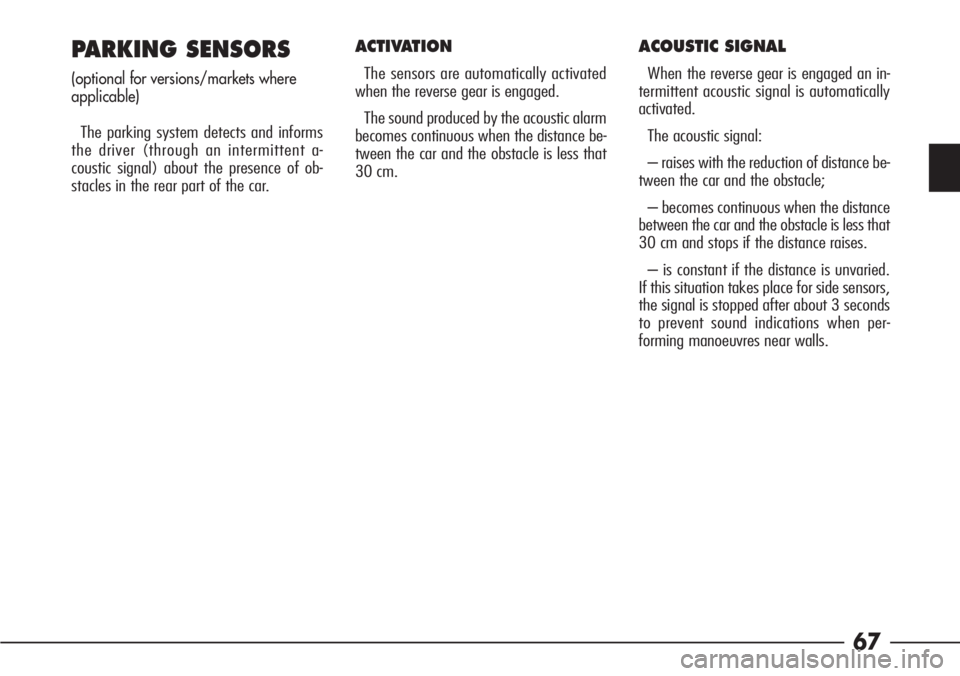
67
PARKING SENSORS
(optional for versions/markets where
applicable)
The parking system detects and informs
the driver (through an intermittent a-
coustic signal) about the presence of ob-
stacles in the rear part of the car.
ACTIVATION
The sensors are automatically activated
when the reverse gear is engaged.
The sound produced by the acoustic alarm
becomes continuous when the distance be-
tween the car and the obstacle is less that
30 cm.
ACOUSTIC SIGNAL
When the reverse gear is engaged an in-
termittent acoustic signal is automatically
activated.
The acoustic signal:
– raises with the reduction of distance be-
tween the car and the obstacle;
– becomes continuous when the distance
between the car and the obstacle is less that
30 cm and stops if the distance raises.
– is constant if the distance is unvaried.
If this situation takes place for side sensors,
the signal is stopped after about 3 seconds
to prevent sound indications when per-
forming manoeuvres near walls.
Page 69 of 272
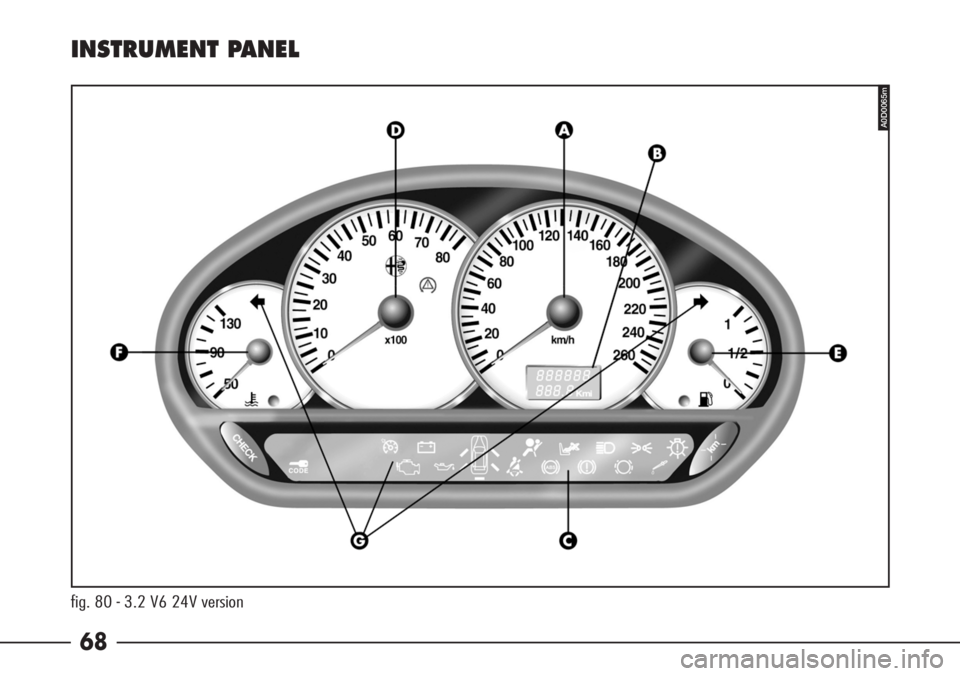
68
fig. 80 - 3.2 V6 24V version
INSTRUMENT PANEL
A0D0065m
Page 70 of 272

69
fig. 81 - JTD 20V Multijet version
A0D0067m